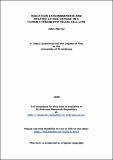Files in this item
Radiation carcinogenesis and delayed lethal damage in a human thyroid epithelial cell line
Item metadata
| dc.contributor.advisor | Riches, Andrew Clive | |
| dc.contributor.advisor | Bryant, Peter Edward | |
| dc.contributor.advisor | Mill, Andrew | |
| dc.contributor.author | Mercer, John | |
| dc.coverage.spatial | 266 p. | en_US |
| dc.date.accessioned | 2016-10-06T09:33:13Z | |
| dc.date.available | 2016-10-06T09:33:13Z | |
| dc.date.issued | 1999 | |
| dc.identifier.uri | https://hdl.handle.net/10023/9613 | |
| dc.description.abstract | The human thyroid epithelial cell HTori-3 has been transformed with doses of either chronic and acute x-rays or strontium beta particles. Models of the past have relied upon animal cell systems to mimic in vitro carcinogenesis. The HTori-3 system hoped to overcome the limitations associated with these types of models by using a human thyroid cell line immortalised with the SV40 virus. HTori-3 human thyroid epithelial cells were irradiated in vitro, passaged and then transplanted into nude mice. Tumours that grew over a 2-6 month period were excised and re-established in culture. Samples were stored and all tumours were taken for histological examination. Chromosome spreads confirmed the human nature of all tumours. Following exposure to acute x-rays in the range of 0.25-2.0 Gy 13 tumours were observed in 25 recipients. Following 0.25-2.0 Gy of chronic x-rays 10 tumours from 25 recipients were observed. From a single 2 Gy exposure of strontium beta particles 3 primary tumours from 5 recipients were observed. The largest of these was re-transplanted in nude mice resulting in 100% incidence. All tumours were classified as undifferentiated anaplastic carcinomas. A small number of tumours were observed in the control cell lines, these may be the result of a general instability found with the partial transformed parental cell line. All 2Gy tumours and those previously established from this laboratory after alpha or gamma radiation were used to test for the presence of the delayed lethal death phenotype. A number of cell and molecular endpoints were used. These included plating efficiency, cell adherence, micronucleus formation and p53 status. In all incidences, the reproductive viability of irradiated cells was below that of non- irradiated cells at up to 4 weeks post-irradiation. The HTori-3 cell line and the techniques used to study the delayed effects of radiation may be applicable to other cell systems and may be a useful model to study the long-term effects of radiation induced genomic instability. | en_US |
| dc.language.iso | en | en_US |
| dc.publisher | University of St Andrews | |
| dc.subject.lcc | QH465.R3M4 | |
| dc.subject.lcsh | Radiation carcinogenesis | en_US |
| dc.subject.lcsh | DNA damage | en_US |
| dc.subject.lcsh | Epithelial cells | en_US |
| dc.title | Radiation carcinogenesis and delayed lethal damage in a human thyroid epithelial cell line | en_US |
| dc.type | Thesis | en_US |
| dc.type.qualificationlevel | Doctoral | en_US |
| dc.type.qualificationname | PhD Doctor of Philosophy | en_US |
| dc.publisher.institution | The University of St Andrews | en_US |
This item appears in the following Collection(s)
Items in the St Andrews Research Repository are protected by copyright, with all rights reserved, unless otherwise indicated.

